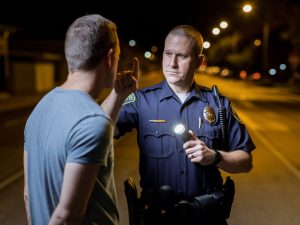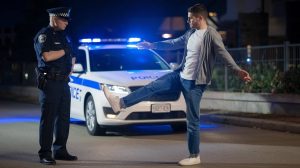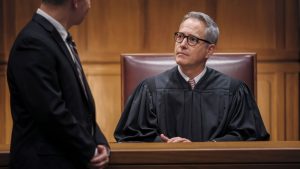In the realm of DUI law enforcement and prosecution, few tools have garnered as much attention and controversy as Standardized Field Sobriety Tests (SFSTs).
These tests, designed to help law enforcement officers assess a driver’s level of impairment, have become a cornerstone of DUI investigations across the United States.
However, their reliability and accuracy have long been the subject of debate among legal professionals, including judges, prosecutors, DUI defense lawyers, expert witnesses, and scientists.
At the heart of this debate lies the San Diego Study, a pivotal research project conducted in 1998 that sought to validate the effectiveness of SFSTs in determining whether a driver’s blood alcohol concentration (BAC) was at or above the legal limit.
That study, funded by the National Highway Traffic Safety Administration (NHTSA), significantly influenced how SFSTs are viewed and used in the legal system. Indeed, the three “standard” SFSTs are nearly ubiquitous in their application nationwide.
As a DUI defense attorney with more than 30 years of practical courtroom experience in North Carolina, I’ve witnessed firsthand the impact of SFSTs on DUI cases – Bill Powers, DUI Defense Lawyer
These tests often play a pivotal role in establishing probable cause for arrest and can heavily influence the determination of guilt or innocence at trial.
However, it’s essential to approach these tests with a critical eye, understanding both their potential usefulness and their limitations.
In this comprehensive analysis, we’ll delve deep into the San Diego Study, examining its methodology, findings, and the controversies surrounding it.
We’ll explore some of the statistical intricacies of the study, unpack the issue of peer review (or lack thereof), and discuss the implications for law enforcement training and courtroom proceedings.
Additionally, we’ll consider how the Daubert standard, which governs the admissibility of Rule 702 expert testimony in North Carolina courts, applies to SFST evidence and conclusions drawn therefrom.
North Carolina DWI Quick Reference Guide
Our goal is to provide a balanced, informative exploration of SFSTs that will be valuable to a diverse audience – from fellow legal professionals and law enforcement officers to judges, prosecutors, and anyone facing DUI charges in North Carolina.
By thoroughly examining the strengths and weaknesses of SFSTs, we aim to foster a more nuanced understanding of these tests and their role in the justice system.
As we navigate through this complex topic, we’ll strive to explain technical concepts in accessible language, ensuring that readers from all backgrounds can grasp the critical issues at play.
We’ll also rely on the data and information provided by the San Diego Study, using direct quotes where necessary to illustrate key points.
Whether you’re a seasoned legal professional looking to deepen your understanding of SFSTs or someone seeking to educate yourself about DUI procedures, this analysis will hopefully provide you with valuable insights into a critical aspect of DUI cases.
Let’s embark on this exploration of Standardized Field Sobriety Tests, their scientific basis, and their practical applications in the legal arena.
Understanding Standardized Field Sobriety Tests (SFSTs): A Brief Overview
Standardized Field Sobriety Tests (SFSTs) have become a universal tool in law enforcement’s arsenal for detecting impaired drivers.
These tests, developed in the 1970s and continually refined, are designed to provide officers with a standardized method of assessing a driver’s level of impairment due to alcohol consumption.
How long is your license suspended?
However, to fully grasp the significance of the San Diego Study, it helps to have a comprehensive understanding of what these tests entail and how they’re supposed to function.
The Three Components of SFSTs
The SFST battery consists of three distinct tests:
- The Horizontal Gaze Nystagmus (HGN)
- The Walk-and-Turn, and
- The One-Leg Stand
Each of these tests is designed to evaluate different aspects of a person’s physical and cognitive functions that may be impaired by alcohol consumption.
The Horizontal Gaze Nystagmus test is perhaps the most scientifically based of the three.
Nystagmus refers to an involuntary jerking of the eyes, which may become more pronounced and occurs at lesser angles of  deviation as a person’s blood alcohol concentration increases.
deviation as a person’s blood alcohol concentration increases.
From the outset, it is relevant to point out that the central nervous system depressant of ethyl alcohol or “ethanol” is not the sole cause of nystagmus.
While imbibing alcohol may result in a discernable “jerking” or “clicking” of the eyes that could be inferred as nystagmus, by no means should it be concluded that if there is an observable nystagmus, it is solely caused by consumption of alcohol, drugs, and/or prescriptions medications.
Nystagmus can be related to:
- History of Stroke
- Traumatic Brain Injury
- Fatigue
- Neurological Conditions and Disease
During the HGN test, an officer holds a stimulus (typically a pen or small flashlight) about 12-15 inches from the subject’s nose and moves it slowly from side to side.
The officer looks for three specific clues in each eye: lack of smooth pursuit, distinct nystagmus at maximum deviation, and onset of nystagmus prior to 45 degrees.
The presence of four or more clues out of a possible six is considered indicative of a BAC at or above 0.08 g/dL.
The Walk-and-Turn test is a divided attention test that challenges the subject’s ability to follow instructions and perform physical movements simultaneously.
Some people refer to this test as the Heel to Toe or the Walk the Line test – Bill Powers, DUI Defense Attorney
The test consists of two phases: an instruction phase and a walking phase. During the instruction phase, the subject must stand heel-to-toe on a line while listening to and remembering a series of instructions.
In the walking phase, the subject takes nine heel-to-toe steps along a straight line, turns in a specific manner, and takes nine heel-to-toe steps back.
Officers look for eight possible clues, including inability to maintain balance during instructions, starting too soon, stopping while walking, missing heel-to-toe, stepping off the line, using arms for balance, improper turn, and taking an incorrect number of steps.
The presence of two or more clues is considered indicative of impairment.
The One-Leg Stand is another divided attention test that requires the subject to stand on one leg while counting aloud for 30  seconds.
seconds.
The officer looks for four clues: swaying while balancing, using arms for balance, hopping, and putting the foot down.
As with the Walk-and-Turn test, the presence of two or more clues is considered indicative of impairment.
Controversies and Limitations of SFSTs
It’s important to note that while these tests are standardized, their effectiveness relies heavily on proper administration by law enforcement officers.
The National Highway Traffic Safety Administration (NHTSA) provides detailed guidelines on how these tests should be conducted, including specific verbal instructions and physical demonstrations.
Any deviation from these standardized procedures can potentially compromise the validity of the test results.
Moreover, it’s important to understand that SFSTs were not designed to measure a specific level of blood alcohol concentration but rather to help officers make informed decisions about whether a driver is likely to be at or above the legal limit.
The tests are meant to be used in conjunction with other observations and evidence, such as the odor of alcohol, slurred speech, or erratic driving behavior.
Here’s How Court Works in North Carolina
Despite their widespread use, SFSTs have faced criticism and scrutiny from various quarters.
Critics argue that these tests can be influenced by a variety of factors unrelated to alcohol consumption, such as age, weight, physical fitness, medical conditions, and environmental conditions.
For instance, a person with an inner ear disorder might struggle with the balance-related aspects of the Walk-and-Turn and One-Leg Stand tests, regardless of their level of intoxication.
Furthermore, the subjective nature of the officer’s observations during these tests has been a point of contention.
While the tests are standardized, the interpretation of a subject’s performance can vary from officer to officer.
This subjectivity introduces a potential for bias or error that defense attorneys often seek to exploit in DUI cases. It also reinforces the need for video recording of all aspects of testing, from start to finish.
SFSTs Admissibility as Evidence in Court
It’s worth noting that while SFSTs are admissible as evidence in many jurisdictions, their weight and interpretation can vary significantly from court to court.
Some judges may view them as highly reliable indicators of impairment, while others may be more skeptical of their scientific validity.
Understanding the nature, purpose, and limitations of SFSTs is important for anyone involved in DUI cases, whether as a legal professional, law enforcement officer, or defendant accused of “drunk driving.”
Impaired Driving Sobriety Tests in the Carolinas
This background provides essential context for evaluating the findings and implications of the San Diego Study, which sought to validate these tests at the 0.08 g/dL BAC level.
As we delve deeper into the study’s results and controversies, this foundational knowledge will help us critically assess the role of SFSTs in DUI enforcement and prosecution.
Introduction to the San Diego Study: Purpose and Methodology
The San Diego Study, published in 1998, stands as a cornerstone in the evaluation of Standardized Field Sobriety Tests (SFSTs) and their application in DUI/DWI cases.
Funded by the National Highway Traffic Safety Administration (NHTSA), this study aimed to validate the effectiveness of SFSTs in determining whether a driver’s blood alcohol concentration (BAC) was at or above the legal limit of 0.08 grams per deciliter (g/dL).
Prior to this study, SFSTs had been validated for a BAC of 0.10 g/dL.
The shift to a lower legal limit in many jurisdictions necessitated a re-evaluation of these tests’ accuracy at the new threshold.
It’s relevant to note that the study’s purpose was not to validate SFSTs as indicators of impairment, but rather as tools to discriminate between BACs above and below the 0.08 g/dL mark.
Much to defense lawyers’ chagrin, this distinction is all too often misunderstood or overlooked in legal proceedings – Bill Powers, DWI Defense Lawyer
The study’s methodology involved seven officers from the San Diego Police Department’s Alcohol Enforcement Unit.
These officers were not only trained in SFST administration but also had significant experience in the field.
To help ensure consistency and proficiency, Dr. Marcelline Burns, one of the study’s authors and a pioneer in SFST development, conducted a four-hour refresher course for the participating officers.
Unlike laboratory-based experiments, the San Diego Study was conducted in the field, involving real-world traffic stops. 
Officers administered SFSTs to drivers who exhibited any objective signs of alcohol consumption, regardless of whether impairment was immediately evident.
This approach aimed to capture a wide range of BAC levels and provide a realistic assessment of the tests’ effectiveness in actual law enforcement scenarios.
The study protocol restricted officers to administering only the standardized battery of field sobriety tests, which includes the Horizontal Gaze Nystagmus (HGN), the Walk-and-Turn, and the One-Leg Stand tests.
After completing the SFSTs, officers obtained BAC measurements for all tested individuals, allowing for a comparison between test performance and actual blood alcohol levels.
The scoring criteria for each test were as follows:
- Horizontal Gaze Nystagmus (HGN): 4 or more clues indicated a BAC of 0.08 g/dL or higher.
- Walk-and-Turn: 2 or more clues indicated a BAC of 0.08 g/dL or higher.
- One-Leg Stand: 2 or more clues indicated a BAC of 0.08 g/dL or higher.
In total, the study involved 297 drivers, with only one individual refusing to submit to BAC testing.
This sample size aimed to provide a statistically significant dataset for analysis.
The Rising BAC Defense: Is it valid in North Carolina Drunk Driving Charges?
It is reasonable to critically inquire whether 297 test subjects, seven police officers, and no medical doctors, nurses, or healthcare professionals from a population of 333 million citizens of the United States amount to a sample size that is statistically reliable and/or relevant to allow for law enforcement, nationwide, to draw broad and often life-altering conclusions.
Clearly, while the San Diego Study has been influential in shaping law enforcement practices and legal arguments in DUI charges, it is not without controversy.
The study’s methodology, particularly its field-based approach, offers both strengths and limitations that warrant careful consideration.
As we delve deeper into the study’s findings and implications, we’ll explore these aspects in detail, providing a balanced view of the San Diego Study’s contribution to our understanding of SFSTs and their role in DUI enforcement.
Our initial conclusion
We’ve explored the foundation of Standardized Field Sobriety Tests and the context of the San Diego Study, which sought to validate these tests at the 0.08 g/dL BAC level. This understanding is a building block for anyone involved in DUI cases, from legal professionals to those facing charges.
However, our exploration of this complex topic is far from over.
How long is your license revoked for DUI in North Carolina?
In our next article, “Analyzing the San Diego Study: SFST Accuracy and Legal Implications,” we’ll delve deeper into the study’s findings and their impact on DUI enforcement and defense.
We’ll examine the key results of the study, unpack the statistical analysis behind the SFSTs, and explore the controversies surrounding the study’s methodology and peer review process. This critical analysis will provide valuable insights for both legal professionals and individuals seeking to understand the complexities of DUI cases.
Stay tuned as we continue to unravel the intricacies of the San Diego Study and its lasting influence on DUI jurisprudence. If you have questions about DUI charges in Mecklenburg, Union, Iredell, Gaston, or Lincoln County NC, call DWI Defense Lawyer Bill Powers now at: 704-342-4357. You may also TEXT Bill Powers at: 704-342-4357.
 Carolina Criminal Defense & DUI Lawyer Updates
Carolina Criminal Defense & DUI Lawyer Updates